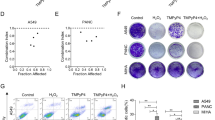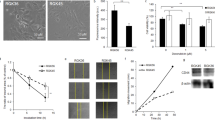Abstract
Photodynamic therapy (PDT) is an established anticancer modality utilizing the photogeneration of reactive oxygen species (ROS) to kill the cancer cells and hypericin is a promising photosensitizer for the treatment of bladder tumors. In this paper we characterize the signaling pathways and the mechanisms leading to the up-regulation of the antioxidant enzyme heme oxygenase (HO-1) in PDT treated cancer cells. We show that PDT engages the p38MAPK and PI3K signaling cascades for HO-1 induction. p38MAPK inhibitors or small interfering RNA (siRNA) for p38MAPK suppress HO-1 induction after PDT and complete repression is attained when p38 and PI3K antagonists are combined. Blocking these signaling pathways increases additively the propensity of the cells to undergo PDT-induced apoptosis, mirroring the effect of HO-1 silencing. Conversely, increasing HO-1 protein level by hemin prior to irradiation is cytoprotective. HO-1 stimulation by PDT is dependent on transcription and de novo protein synthesis and it is preceded by the nuclear accumulation of the Nrf2 transcription factor, which is reduced by inhibitors of p38MAPK and PI3K. Altogether these results indicate that stimulation of HO-1 expression by hypericin-PDT is a cytoprotective mechanism governed by the p38MAPK and PI3K pathways, likely through the control of the nuclear availability of the Nrf2 pool.






Similar content being viewed by others
Abbreviations
- ActD:
-
actinomycin D
- AREs:
-
antioxidant response elements
- B2M:
-
β2-microglobulin
- COX-2:
-
cyclooxygenase-2
- ER:
-
endoplasmic reticulum
- HO-1:
-
heme oxygenase 1
- Hyp:
-
Hypericin
- Nrf2:
-
NF-E2-related factor-2
- p38MAPK :
-
p38 mitogen-activated protein kinase
- PDT:
-
photodynamic therapy
- PGE2 :
-
prostaglandin E2
- PI3K:
-
phosphatidylinositol 3-kinase
- ROS:
-
reactive oxygen species
- ZnPPIX:
-
zinc protoporphyrin IX
References
Dolmans DE, Fukumura D, Jain RK (2003) Photodynamic therapy for cancer. Nat Rev Cancer 3:380–387
Buytaert E, Callewaert G, Hendrickx N et al (2006) Role of endoplasmic reticulum depletion and multidomain proapoptotic BAX and BAK proteins in shaping cell death after hypericin-mediated photodynamic therapy. FASEB J 20:756–758
Agostinis P, Vantieghem A, Merlevede W, de Witte PA (2002) Hypericin in cancer treatment: more light on the way. Int J Biochem Cell Biol 34:221–241
Dougherty TJ, Gomer CJ, Henderson BW et al (1998) Photodynamic therapy. J Natl Cancer Inst 90:889–905
Hendrickx N, Volanti C, Moens U et al (2003) Up-regulation of cyclooxygenase-2 and apoptosis resistance by p38 MAPK in hypericin-mediated photodynamic therapy of human cancer cells. J Biol Chem 278:52231–52239
Volanti C, Hendrickx N, Van Lint J, Matroule JY, Agostinis P, Piette J (2005) Distinct transduction mechanisms of cyclooxygenase 2 gene activation in tumour cells after photodynamic therapy. Oncogene 24:2981–2991
Romano M, Claria J (2003) Cyclooxygenase-2 and 5-lipoxygenase converging functions on cell proliferation and tumor angiogenesis: implications for cancer therapy. FASEB J 17:1986–1995
Hendrickx N, Dewaele M, Buytaert E et al (2005) Targeted inhibition of p38alpha MAPK suppresses tumor-associated endothelial cell migration in response to hypericin-based photodynamic therapy. Biochem Biophys Res Commun 337:928–935
Ryter SW, Alam J, Choi AM (2006) Heme oxygenase-1/carbon monoxide: from basic science to therapeutic applications. Physiol Rev 86:583–650
Martin D, Rojo AI, Salinas M et al (2004) Regulation of heme oxygenase-1 expression through the phosphatidylinositol 3-kinase/Akt pathway and the Nrf2 transcription factor in response to the antioxidant phytochemical carnosol. J Biol Chem 279:8919–8929
Alam J, Killeen E, Gong P et al (2003) Heme activates the heme oxygenase-1 gene in renal epithelial cells by stabilizing Nrf2. Am J Physiol Renal Physiol 284:F743–752
Dennery PA, Visner G, Weng YH et al (2003) Resistance to hyperoxia with heme oxygenase-1 disruption: role of iron. Free Radical Biol Med 34:124–133
Gomer CJ, Luna M, Ferrario A, Rucker N (1991) Increased transcription and translation of heme oxygenase in Chinese hamster fibroblasts following photodynamic stress or photofrin II incubation. Photochem Photobiol 53:275–279
Nowis D, Legat M, Grzela T et al (2006) Heme oxygenase-1 protects tumor cells against photodynamic therapy-mediated cytotoxicity. Oncogene 25:3365–3374
Chen B, Roskams T, Xu Y, Agostinis P, de Witte PA (2002) Photodynamic therapy with hypericin induces vascular damage and apoptosis in the RIF-1 mouse tumor model. Int J Cancer 98:284–290
Vantieghem A, Xu Y, Assefa Z et al (2002) Phosphorylation of Bcl-2 in G2/M phase-arrested cells following photodynamic therapy with hypericin involves a CDK1-mediated signal and delays the onset of apoptosis. J Biol Chem 277:37718–37731
Jazwa A, Loboda A, Golda S et al (2006) Effect of heme and heme oxygenase-1 on vascular endothelial growth factor synthesis and angiogenic potency of human keratinocytes. Free Radic Biol Med 40:1250–1263
Cheng PY, Lee YM, Shih NL, Chen YC, Yen MH (2006) Heme oxygenase-1 contributes to the cytoprotection of alpha-lipoic acid via activation of p44/42 mitogen-activated protein kinase in vascular smooth muscle cells. Free Radic Biol Med 40:1313– 1322
Kang KW, Lee SJ, Kim SG (2005) Molecular mechanism of nrf2 activation by oxidative stress. Antioxid Redox Signal 7:1664–1673
Nguyen T, Sherratt PJ, Nioi P, Yang CS, Pickett CB (2005) Nrf2 controls constitutive and inducible expression of ARE-driven genes through a dynamic pathway involving nucleocytoplasmic shuttling by Keap1. J Biol Chem 280:32485–32492
Itoh K, Ishii T, Wakabayashi N, Yamamoto M (1999) Regulatory mechanisms of cellular response to oxidative stress. Free Radic Res 31:319–324
Talalay P (2000) Chemoprotection against cancer by induction of phase 2 enzymes. BioFactors 12:5–11
Kang KW, Lee SJ, Park JW, Kim SG (2002) Phosphatidylinositol 3-kinase regulates nuclear translocation of NF-E2-related factor 2 through actin rearrangement in response to oxidative stress. Mol Pharmacol 62:1001–1010
Kobayashi A, Kang MI, Watai Y et al (2006) Oxidative and electrophilic stresses activate Nrf2 through inhibition of ubiquitination activity of Keap1. Mol Cell Biol 26:221–229
Cullinan SB, Zhang D, Hannink M, Arvisais E, Kaufman RJ, Diehl JA (2003) Nrf2 is a direct PERK substrate and effector of PERK-dependent cell survival. Mol Cell Biol 23:7198–7209
Cullinan SB, Diehl JA (2004) PERK-dependent activation of Nrf2 contributes to redox homeostasis and cell survival following endoplasmic reticulum stress. J Biol Chem 279:20108–20117
Bloom DA, Jaiswal AK (2003) Phosphorylation of Nrf2 at Ser40 by protein kinase C in response to antioxidants leads to the release of Nrf2 from INrf2, but is not required for Nrf2 stabilization/accumulation in the nucleus and transcriptional activation of antioxidant response element-mediated NAD(P)H:quinone oxidoreductase-1 gene expression. J Biol Chem 278:44675–44682
Boudrez A, Beullens M, Groenen P et al (2000) NIPP1-mediated Interaction of protein phosphatase-1 with CDC5L a regulator of pre-mRNA splicing and mitotic entry. J Biol Chem 275:25411–25417
Assefa Z, Vantieghem A, Declercq W et al (1999) The activation of the c-Jun N-terminal kinase and p38 mitogen-activated protein kinase signaling pathways protects HeLa cells from apoptosis following photodynamic therapy with hypericin. J Biol Chem 274:8788–8796
Acknowledgments
This work was supported by the Geconcerteerde Onderzoeksacties (GOA, from the KU.Leuven), the Interuniversitaire Attractiepolen (IAP, V/P12) of the Federal Belgian Government and by F.W.O grant G.0104.02. SK was supported by a grant from the Belgian Federal Science Policy Office.
Author information
Authors and Affiliations
Corresponding author
Rights and permissions
About this article
Cite this article
Kocanova, S., Buytaert, E., Matroule, JY. et al. Induction of heme-oxygenase 1 requires the p38MAPK and PI3K pathways and suppresses apoptotic cell death following hypericin-mediated photodynamic therapy. Apoptosis 12, 731–741 (2007). https://doi.org/10.1007/s10495-006-0016-x
Published:
Issue Date:
DOI: https://doi.org/10.1007/s10495-006-0016-x




